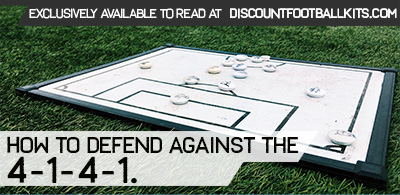While most tactical setups that we see deployed in modern football are variations of the classic 3-5-2 or 4-4-2 shapes, each tend to be increasingly defined and dictate relatively specific roles to individual players.
Take the 4-1-4-1 shape, for example, which has become popularised at a time when teams are inclined to operate with more than one player in an advanced “number eight” position and potentially support the sole defensive pivot with one or more inverted full backs.
Regardless, the 4-1-4-1 is a highly structured and detailed formation, and one that has various strengths and weaknesses. We’ll take at these in more detail below, while asking how you can successfully play and defend against the system.
A Closer Look at the 4-1-4-1
This shape features four distinct lines, with a sole defensive midfield patrolling the central space in front of a flat back four.
Another line of four plays in front of the defensive midfield screen, including two advanced ‘eights’ and a wide forward (or winger) on each flank. Then there’s a sole striker, who will be tasked with pressing the opposing centre halves and holding the ball up during the build-up phase.
One of the key advantages of the 4-1-4-1 is that it offers flexibility in the midfield and final third, depending on the profile of the players selected. For example, Arsenal’s starting shape resembled a 4-1-4-1 for much of last season, with Granite Xhaka operating as an advanced eight when the Gunners had possession and dropping deeper alongside Thomas Partey during defensive phases.
When operating with an inverted full back, the formation can seamlessly be adapted into a 3-2-4-1 shape during attacking phases and build-up play, further emboldening the attacking central midfielders and making it easier to press high up the park.
The formation is also great from the perspective of squeezing the space between defence and midfield, making it difficult for opposing attackers to find room during defensive phases and transitions.
This further highlights the solid structural foundation provided by the 4-1-4-1, which is central to why the shape has become so popular in recent seasons.
How to Play (and Defend) Against the 4-1-4-1
The question that remains, of course, is how can you set up your team to play against and successfully nullify the various strengths of the 4-1-4-1 shape? Here are some ideas to keep in mind!
- #1. Adopt a High and Aggressive Press: One of the pitfalls of the 4-1-4-1 is that it can easily transition into rigid and deep 4-5-1 shape when a side is put under pressure (once again depending on the personnel selected). So, adopting a high and aggressive press may provide the best form of defence when the ball is lost, as you look to push your opponents back and negate the supply into the wide attackers or advanced number eights. This can be particularly effective when playing a 3-5-2 formation, as you can press man-for-man while pushing your wingbacks high against their opposing fullbacks.
- #2. Target the Sole Defensive Midfielder: If your opponents don’t deploy an inverted fullback to supplement their sole midfield anchor, you may want to consider targeting this player with strategic and constant pressure. One way to do this is to detail a deep-lying forward or number 10 to man-mark the defensive midfielder, applying pressure as soon as they receive the ball and closing off forward passing lanes. This can lead to high turnovers and counterattacks where the opposition is outnumbered centrally.
- #3. Evade the Opponent’s Press: Teams that play the 4-1-4-1 typically leverage the formation’s structure and shape to press high themselves, with the advancement of the attacking midfield four lending itself to the effective squeezing of their opponent’s defensive line. However, one way to counter this is by adopting a more direct build-up style, using longer passes to beat the front-line press and reach either the central midfield or wide areas. Of course, you’ll need to refine your own attacking and defensive shape to do this successfully, but it may also make it easier to counter effectively and isolate the defensive midfielder and back four.
The Last Word
The 4-1-4-1 is an incredibly structured and increasingly popular formation, and one that requires a tactically astute manager and players with a keen positional understanding.
Like all shapes and systems, however, the 4-1-4-1 formation has vulnerabilities that can be targeted, particularly as the deployment of four playing lines may occasionally isolate players and make them vulnerable to targeted pressing.
A high pressing style can certainly be effective when defending against the 4-1-4-1, especially if you’re willing to adopt a variation of the trusted 3-5-2 shape and go man-for-man.










